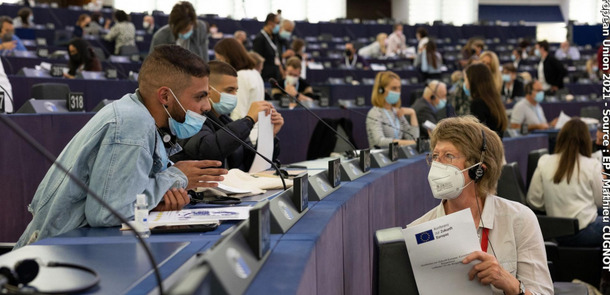Cushioning crises is the basic idea behind a European unemployment re-insurance scheme. Euro countries could create a financial pot that supports members in severe crises in order to prevent contagion and high unemployment. What some advocate as necessary stabilization is criticized by others as a transfer union.
The global financial crisis in 2008 has shown the EU how quickly a domino effect can arise: If some EU countries run into financial difficulties, there is a risk of contagion in other member states. Rising debt levels, currency turbulence and high unemployment are potential consequences. A European unemployment re-insurance scheme could partly safeguard the Eurozone from these threats. It would have absorbed just under a quarter of the income losses in the Eurozone caused by unemployment between 2000 and 2016. In the crisis year of 2009, income losses due to rising unemployment would have been cushioned by more than 14 billion euros. Germany, for example, would also have received around 2.5 billion euros from the fund in 2003 when the country experienced a sharp rise in unemployment figures.
These is the results of our analysis carried out by the Ifo Institute. The study examines the impact of a re-insurance for national unemployment insurance in the Eurozone between the years 2000 and 2016. The calculations simulate that each euro area country pays a share into the same pot in times of falling unemployment. Members of the euro area will receive payments if their unemployment rate in severe crises is above the average of previous years and the unemployment rate rises significantly within a year.
Among the countries that would have benefited most from reinsurance are not only euro countries from the South: in Austria, Finland and Cyprus, the re-insurance scheme would have absorbed almost a quarter (24 percent) of the income losses caused by unemployment. This means that these countries would have received most funds over the entire period, measured relative to the magnitude of the crisis in these countries. But the re-insurance could also have absorbed 21 percent of the shocks in France, Spain and Ireland. In Germany, around one fifth of the income losses would have been cushioned by a common financial pot during crises.
No permanent transfers
A major point of criticism of a Europe-wide re-insurance system are permanent transfer payments, which would primarily affect economically strong countries such as Germany. The reinsurance simulated in the study could possibly refute part of these fears. "In the period between 2000 and 2016, no country would have been a net contributor or a net recipient in every year," says Christian Kastrop, our Europe expert. On average, the member states would have paid less than 0.1 percent of their gross domestic product (GDP) annually. In total, all member states except Belgium and Malta would have received payments in at least one year since the introduction of the euro and would have had to pay into the fund at least three times.
What would a European re-insurance scheme look like?
The model simulated in the study works as follows: In times of declining unemployment, a country pays contributions, while payments to support national unemployment insurance schemes are only made in major crises. This is to ensure that there are no incentives for poor economic and fiscal policy – because in small and medium-sized crises countries receive no support and would have to bear the cost of poor policy. Payouts are linked to conditions: First, the unemployment rate in a member state must be above the average of recent years. Second, the unemployment rate must rise sharply within a year. "Unemployment re-insurance should stabilize the Eurozone without creating false incentives. A model that provides support only in serious crises and just temporarily can promote both solidarity and market discipline in the Eurozone," says Mr. Kastrop.
Principle of insurance and loans as potential stabilizers
The study separates stabilization effects of the re-insurance scheme into two components: First, it shows the potential for stabilization through payments between insured countries – these payments are triggered because labor market fluctuations between countries differ, i.e., they are asymmetric. Secondly, it measures the stabilization that member states experience when they can borrow in times of crisis – this loan-based component is also part of the German Federal Ministry of Finance's proposal for a re-insurance scheme. The study suggests that both channels can contribute to the stabilizing effect of an unemployment re-insurance. In principle, however, member states could also opt for loans on financial markets, so that the first channel most closely corresponds to the insurance principle.
According to Dominic Ponattu, our economic expert, "A re-insurance scheme can dampen the strong and still diverging economic fluctuations in the Eurozone.” Income losses would be absorbed in bad times as described above, so that national insurance systems would not have to increase contributions or cut payments to the unemployed during crises. At the same time, countries must build up reserves in good times, which can protect them from overspending and prevent the economy from overheating. Different minimum standards for national unemployment insurance play no role. It is not the level of unemployment that is decisive, but its rate of change. "In the re-insurance scheme, states with low unemployment rates are by no means subsidizing those with high unemployment rates. What matters are short-term changes in unemployment, not differences in levels," says Mr. Ponattu. This would also speak against the often cited criticism that re-insurance would promote a backlog of reforms. Countries currently undertaking structural reforms towards more flexible labor markets could therefore benefit strongly from the re-insurance scheme. The study points out that the availability of re-insurance in member states could also be linked to compliance with European fiscal rules in order to promote additional stability in the Eurozone.
Study
Summary
Additional information
The study "An Unemployment Re-Insurance Scheme for the Eurozone? Stabilizing and Redistributive Effects" simulated the impact of a re-insurance scheme that supports national unemployment insurances in the euro area for the period from 2000 to 2016. The analysis was carried out by the ifo Institute on behalf of Bertelsmann Stiftung. The study uses Eurostat budget micro-data from the European Labour Force Survey and Community Statistics on Income and Living Conditions (EU SILC) to estimate labor market developments and the resulting income fluctuations in the current 19 euro area member states for the period 2000-2016. The simulation calculates the stabilization and distributional effects of an unemployment re-insurance scheme, assuming that it had been introduced at the beginning of 2000. The scheme requires two conditions for payments from re-insurance. First, the unemployment rate in a member state must be above the average of previous years. Second, there must be a sharp increase in the unemployment rate within a year. The study considers threshold values for the required rate of change in unemployment of one and two percentage Points.
Further Information will be found here.




